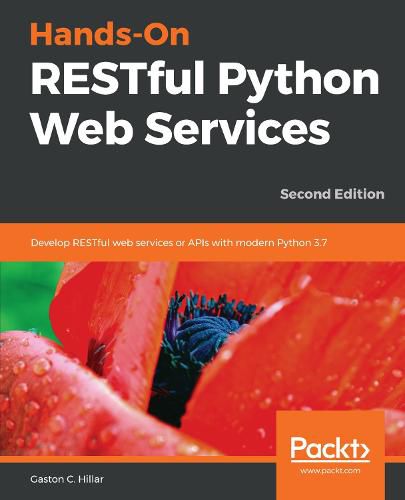Readings Newsletter
Become a Readings Member to make your shopping experience even easier.
Sign in or sign up for free!
You’re not far away from qualifying for FREE standard shipping within Australia
You’ve qualified for FREE standard shipping within Australia
The cart is loading…






This title is printed to order. This book may have been self-published. If so, we cannot guarantee the quality of the content. In the main most books will have gone through the editing process however some may not. We therefore suggest that you be aware of this before ordering this book. If in doubt check either the author or publisher’s details as we are unable to accept any returns unless they are faulty. Please contact us if you have any questions.
Explore the best tools and techniques to create lightweight, maintainable, and scalable Python web services
Key Features
Combine Python with different data sources to build complex RESTful APIs from scratch Configure and fine-tune your APIs using the best tools and techniques available Use command-line and GUI tools to test CRUD operations performed by RESTful Web Services or APIs
Book DescriptionPython is the language of choice for millions of developers worldwide that builds great web services in RESTful architecture. This second edition of Hands-On RESTful Python Web Services will cover the best tools you can use to build engaging web services.
This book shows you how to develop RESTful APIs using the most popular Python frameworks and all the necessary stacks with Python, combined with related libraries and tools. You’ll learn to incorporate all new features of Python 3.7, Flask 1.0.2, Django 2.1, Tornado 5.1, and also a new framework, Pyramid. As you advance through the chapters, you will get to grips with each of these frameworks to build various web services, and be shown use cases and best practices covering when to use a particular framework.
You’ll then successfully develop RESTful APIs with all frameworks and understand how each framework processes HTTP requests and routes URLs. You’ll also discover best practices for validation, serialization, and deserialization. In the concluding chapters, you will take advantage of specific features available in certain frameworks such as integrated ORMs, built-in authorization and authentication, and work with asynchronous code. At the end of each framework, you will write tests for RESTful APIs and improve code coverage.
By the end of the book, you will have gained a deep understanding of the stacks needed to build RESTful web services.
What you will learn
Select the most appropriate framework based on requirements Develop complex RESTful APIs from scratch using Python Use requests handlers, URL patterns, serialization, and validations Add authentication, authorization, and interaction with ORMs and databases Debug, test, and improve RESTful APIs with four frameworks Design RESTful APIs with frameworks and create automated tests
Who this book is forThis book is for web developers who have a working knowledge of Python and would like to build amazing web services by taking advantage of the various frameworks of Python. You should have some knowledge of RESTful APIs.
$9.00 standard shipping within Australia
FREE standard shipping within Australia for orders over $100.00
Express & International shipping calculated at checkout
This title is printed to order. This book may have been self-published. If so, we cannot guarantee the quality of the content. In the main most books will have gone through the editing process however some may not. We therefore suggest that you be aware of this before ordering this book. If in doubt check either the author or publisher’s details as we are unable to accept any returns unless they are faulty. Please contact us if you have any questions.
Explore the best tools and techniques to create lightweight, maintainable, and scalable Python web services
Key Features
Combine Python with different data sources to build complex RESTful APIs from scratch Configure and fine-tune your APIs using the best tools and techniques available Use command-line and GUI tools to test CRUD operations performed by RESTful Web Services or APIs
Book DescriptionPython is the language of choice for millions of developers worldwide that builds great web services in RESTful architecture. This second edition of Hands-On RESTful Python Web Services will cover the best tools you can use to build engaging web services.
This book shows you how to develop RESTful APIs using the most popular Python frameworks and all the necessary stacks with Python, combined with related libraries and tools. You’ll learn to incorporate all new features of Python 3.7, Flask 1.0.2, Django 2.1, Tornado 5.1, and also a new framework, Pyramid. As you advance through the chapters, you will get to grips with each of these frameworks to build various web services, and be shown use cases and best practices covering when to use a particular framework.
You’ll then successfully develop RESTful APIs with all frameworks and understand how each framework processes HTTP requests and routes URLs. You’ll also discover best practices for validation, serialization, and deserialization. In the concluding chapters, you will take advantage of specific features available in certain frameworks such as integrated ORMs, built-in authorization and authentication, and work with asynchronous code. At the end of each framework, you will write tests for RESTful APIs and improve code coverage.
By the end of the book, you will have gained a deep understanding of the stacks needed to build RESTful web services.
What you will learn
Select the most appropriate framework based on requirements Develop complex RESTful APIs from scratch using Python Use requests handlers, URL patterns, serialization, and validations Add authentication, authorization, and interaction with ORMs and databases Debug, test, and improve RESTful APIs with four frameworks Design RESTful APIs with frameworks and create automated tests
Who this book is forThis book is for web developers who have a working knowledge of Python and would like to build amazing web services by taking advantage of the various frameworks of Python. You should have some knowledge of RESTful APIs.